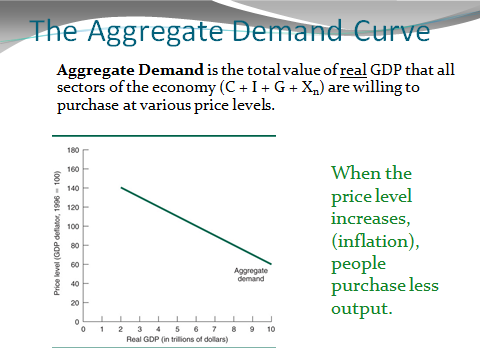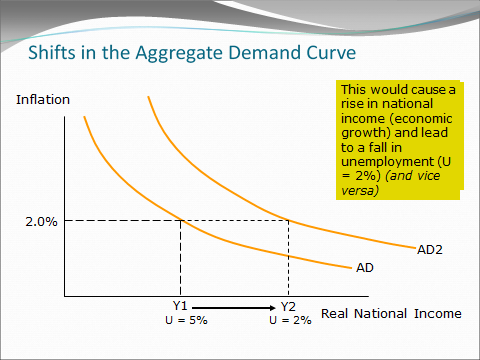Aggregate Demand, Shifts of the Aggregate Demand Curve
Совокупный спрос (АD)– это реальный объем валового внутреннего продукта, который домашние хозяйства, фирмы и государство готовы приобретать при каждом данном уровне цен, т.е. экономический агрегат, суммирующий величины локальных спросов на все товары и услуги, предлагаемые на рынке.
Включает в себя:
- потребительский спрос;
- инвестиционный спрос;
- спрос со стороны государства;
- чистый экспорт.
Aggregate demand (AD) is the total demand by domestic and foreign households and firms for an economy's scarce resources, less the demand by domestic households and firms for resources from abroad.
Aggregate means ‘total’ and in this case we use the term to measure how much is being spent by all consumers, businesses, the government and people and firms overseas.
Aggregate demand (AD) = total spending on goods and services.
— The sum of all expenditure in the economy over a period of time
— Macro concept – WHOLE economy
— Formula:
AD = C+I+G+(X-M)
— C= Consumption Spending
— I = Investment Spending
— G = Government Spending
— (X-M) = difference between spending on imports and receipts from exports (Balance of Payments)

— The AD diagram:
— Inflation on the vertical axis
— Real GDP or Real National Income or Real Output on the vertical axis (shown by the initial Y)
— Why does it slope down from left to right?
— Assume Bank of England sets short term interest rates
— Assume a rise in the price level will be met by a rise in interest rates
— Any increase in interest rates will raise the cost of borrowing:
— Consumption spending will fall
— Investment will fall
— International competitiveness will decrease – exports fall, imports rise
— Therefore – a rise in the price level leads to lower levels of aggregate demand
To derive the aggregate demand curve, we examine what happens to aggregate output (income) (Y) when the price level (P) changes, assuming no changes in government spending (G), net taxes (T), or the monetary policy variable (Ms).


There are several explanations for an inverse relationship between AD and the price level in an economy:
1.Falling real incomes: As the price level rises, the real value of people’s incomes fall and consumers are less able to buy the items they want or need. If over the course of a year all prices rose by 10 per cent whilst your money income remained the same, your real income would have fallen by 10%
2.Interest rate effect: if the price level rises, this causes inflation and an increase in the demand for money and a possible rise in interest rates with a deflationary effect on the economy. This assumes that the central bank (in our case the Bank of England) is setting interest rates in order to meet a specified inflation target.
WHAT INFLUENCE AGGREGATE DEMAND
Changes in Expectations Current spending is affected by anticipated income and inflation
• When confidence falls, we see an increase in saving and businesses postpone investment projects because of worries over weak demand and lower expected profits.
• Changes in Monetary Policy – i.e. a change in interest rates
• If interest rates fall – this lowers the cost of borrowing and the incentive to save, encouraging consumption & investment
• There are time lags between changes in interest rates and AD
• Changes in Fiscal Policy Fiscal Policy refers to changes in government spending, taxation and borrowing
• Income tax affects disposable income e.g. lower income tax raises disposable income and should boost consumption.
• A budget deficit is a net injection of aggregate demand
• economic events in the world economy International factors such as the exchange rate and foreign income
• A depreciation in a currency makes imports dearer and exports cheaper - the net result should be that AD rises
• An increase in overseas incomes raises demand for exports. In contrast a recession in a major export market will lead to a fall in exports and an inward shift of aggregate demand.
• Changes in household wealth
• Changing share and property prices affect the level of wealth
• Declining asset prices can hit confidence / a fall in expectations
